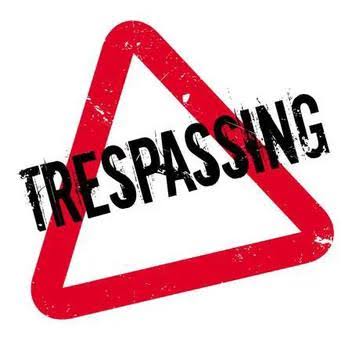“No Trespassing” signs serve a vital role in establishing and communicating property boundaries, ensuring that individuals understand they are not allowed to enter a particular area without permission. These signs play a crucial part in safeguarding private property, preserving security, and preventing potential conflicts. However, it’s intriguing to observe that many of these signs include the term “Posted” alongside the phrase “No Trespassing.” This seemingly simple addition raises questions about its significance and purpose, which we’ll explore in depth.
The use of “Posted” signs instead of “No Trespassing” signs is a colloquialism that has evolved over time, particularly in rural and semi-rural areas of the United States. While it may seem like a curious linguistic quirk, there are historical, cultural, and legal reasons behind the prevalence of “Posted” signs. Understanding the origins and implications of these signs requires exploring various aspects, including property rights, trespass laws, language evolution, and regional customs. In this essay, we will delve deep into the significance of “Posted” signs and why they are commonly used.
Legal Significance of Using the Words Posted on a ‘No Trespass’ Sign
A ‘no trespass’ sign with the words ‘Posted’ is a common tool used by property owners to assert their rights and protect their land from unauthorized access. These signs typically contain specific language that informs individuals that they are not allowed to enter the property without permission. The legal significance of the words posted on a ‘no trespass’ sign is a crucial aspect of property law and can impact various legal proceedings. This segment delves into the legal implications of the language used on such signs.
Trespass refers to the unauthorized entry onto another person’s property without their consent. It can involve physical intrusion onto the land or remaining on the property after being asked to leave. The use of ‘no trespass’ signs serves as a clear indication to individuals that their entry is prohibited. Courts often interpret the presence of these signs as evidence of the property owner’s intent to protect their property rights.
Why Do Many ‘No Trespass’ Sign Say Posted?
The term “Posted” carries significant legal weight in the context of trespassing laws. It acts as a form of notice that informs individuals about the landowner’s intentions and their rights to control access to their property. In many jurisdictions, including the term “Posted” on a sign can simplify the burden of proof for landowners if they need to take legal action against trespassers. Courts often interpret “Posted” signs as clear and explicit communication of the property owner’s wishes, enhancing the property owner’s legal standing.
When properly displayed, a ‘no trespass’ sign creates a legal presumption that the person who enters the property had knowledge of the restriction. This is often referred to as “constructive notice.” In legal proceedings, this presumption can be used to support the property owner’s claim of trespass against an individual who entered the property without permission.
Elements of an Effective ‘No Trespass’ Sign
For a ‘no trespass’ sign with the words posted to hold legal significance, it must meet certain criteria:
1. Visibility and Placement: The sign should be clearly visible and strategically placed at entrances or key points of the property. This ensures that anyone approaching the property is aware of the restriction.
2. Language and Content: The sign’s language must be unambiguous and straightforward. It should explicitly state that entry without permission is prohibited. Ambiguous language or unclear wording could weaken the sign’s legal impact.
3. Size and Font: The size and font of the sign should be legible, allowing individuals to read and understand the message easily. Illegible signs may fail to communicate the intended message effectively.
Liability and Consequences: Posted Property
The legal significance of a ‘no trespass’ sign with the words posted extends beyond just notice. If an individual disregards the sign and enters the property, the property owner may have stronger grounds to hold them liable for trespass. This can lead to legal remedies such as injunctions to prevent further trespassing, damages for any harm caused, and even criminal charges in some jurisdictions.
While ‘no trespass’ signs are powerful tools for asserting property rights, there are certain limitations and exceptions. For example, emergency responders may be exempt from the restrictions if their entry is necessary to save lives or prevent property damage. Additionally, some jurisdictions may have specific rules regarding the use of deadly force to protect property, which could impact the legal consequences of trespass.
In the realm of property law, the legal significance of using specific words on a ‘no trespass’ sign is profound. These signs serve as a clear declaration of a property owner’s intent to protect their land from unauthorized access. When properly designed, placed, and worded, these signs create a legal presumption of notice and can strengthen the property owner’s position in legal proceedings involving trespass. However, understanding the nuances of local laws and regulations is essential to effectively enforce the restrictions imposed by ‘no trespass’ signs
Historical Context: Posted Property
The inclusion of “Posted” on “No Trespassing” signs has historical roots that stretch back to early property rights and land ownership practices. In times when written contracts were less common, landowners needed a clear and straightforward way to signal their ownership and control over their property. “Posted” likely emerged as a concise method to convey this message, indicating that the land was officially claimed and protected against unauthorized entry.
As societies evolved, so did property laws and legal frameworks. The concept of “Posted” continued to be relevant, serving as a means to establish intent and provide legal grounds for enforcing trespassing regulations. Over time, the use of this term became standardized and recognized by courts as a valid form of notice, strengthening its legal significance.
Property Rights Communication: Posted Property
Clear communication of property boundaries is paramount to avoid misunderstandings and disputes. “Posted” signs go beyond a simple statement of “No Trespassing” by explicitly indicating that the property is private and protected. This serves as a visual marker of the landowner’s intent, ensuring that potential trespassers are aware of the limits of their access.
Effectiveness of Signage: Posted Property
The inclusion of “Posted” on “No Trespassing” signs significantly contributes to their effectiveness. The term acts as a deterrent by conveying a sense of authority and legality. Trespassers may be more likely to take the sign seriously when they see the word “Posted,” understanding that the property owner is committed to protecting their land and pursuing legal action if necessary.
Alternative Wordings: Posted Property
While “Posted” is a widely recognized term, some property owners may opt for alternative wordings on their signs, such as “Private Property” or “Keep Out.” These alternatives can convey a similar message, but their legal implications might vary depending on local laws and judicial interpretations.
Are “Posted” signs legally binding, and what are the consequences of trespassing on property marked with these signs?
While the legal implications of “Posted” signs can vary depending on jurisdiction, they are generally considered effective in providing notice to potential trespassers. In many states, the presence of a “Posted” sign serves as sufficient warning that the property is private, and unauthorized entry is prohibited. Trespassing on land marked with “Posted” signs can result in criminal or civil penalties, depending on the severity of the offense and local laws. However, it’s essential to note that the enforceability of “Posted” signs may be subject to specific requirements regarding signage placement and visibility. Additionally, landowners may have recourse to legal action against trespassers to protect their property rights and seek compensation for any damages incurred.
In conclusion, the inclusion of “Posted” on “No Trespassing” signs is rooted in historical practices, holds legal significance, and plays a pivotal role in communicating property boundaries. Its presence enhances the effectiveness of signs in deterring trespassers and provides a clear indication of the landowner’s intent. While cultural and regional variations exist, the concept of “Posted” continues to serve as a vital tool in maintaining property rights and preserving security in modern society.
Last updated on: April 20, 2024



